Oak, Bourbon, and Homebrew Volume II – Barrels
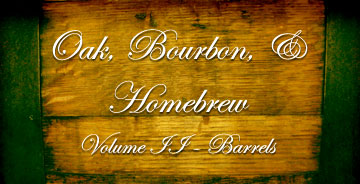
This is my second entry in a series of posts about using oak in home brewing. My first post on the topic focused mainly on using oak cubes and chips, but for this one, I’ll talk about my experience using an actual barrel.
My experience using barrels started when Great Fermentations got a hold of a once used Templeton Rye barrel, which ultimately started our whole barrel program here. If you were able to try our first beer aged in the barrel (rightfully named Temple of Rye) then you know the results were great. Our second beer is in the barrel right now, and based on the success of the first round, we’ve got high expectations. More on our barrel program soon in another post, but in the meantime here is a picture that correctly shows the power that beer from a rye barrel can have on someone:
Anyways, armed with my experiences from using our barrel at work, I was keen to give it a shot at home, and jumped on the opportunity when Great Fermentations got in some 15 gallon used Rye barrels from Dad’s Hat Rye out of Pennsylvania. My experience though was not 100% transferable, as smaller barrels have their own set of challenges.
It’s important to understand that smaller barrels have a much higher surface to volume ratio than their full sized counterparts. In other words, the more surface area of wood in contact with a smaller volume of beer (or wine, whisky, rum, etc), the faster the exchange of flavors will take place. Still with me? It’s similar to using oak chips vs. cubes; the process will happen faster with the chips that have the larger surface area.
Besides pulling out all the oaky goodness (as well as spirit flavor) faster, a larger surface to volume ratio also means that oxidation happens more rapidly, accelerating the aging process. In some ways this can be a good thing, but the downside is that Acetobacter, the acid producing bacteria that makes Flanders Red Ales so delicious (and vinegar so vinegary), really really likes wood and thrives in oxygen rich environments, greatly increasing the risk of infection.
Wax on, wax off (well maybe just wax on)…
You can’t do much to slow down the extraction of the oak and all it’s flavors, but there is a good, relatively easy way to slow down the speed that oxidation takes place so that it’s about equal to a full size barrel. You can ensure this by covering a certain percentage of the outside of the barrel using standard paraffin wax.
If using a 5 gallon barrel, you’ll want to wax all of the outside of the barrel, leaving the heads (the barrel ends) unwaxed. A 10 gallon barrel you’d wax about 75%, minus the heads, and for a 15 gallon barrel (the size of ours) you’d want to wax about 50%, minus the heads. The waxing process isn’t too hard. Paraffin blocks are available from most hobby stores, and I used a super high tech double boiler setup to melt it down :)
Next, I used newspaper and tape to mask off the half of the barrel that I didn’t want waxed.
Then using a combination of an old beat up paintbrush I found in the basement and a scientific kinda “drizzle it on technique”, I gave my barrel a nice coat of wax. You probably should do this step outside or at least in the garage to avoid your better half’s wrath, but it was really cold in the garage that day and I can be sorta wimpy. Proper attire is also very, very important.
I would have preferred to take a propane torch to the outside of the barrel once it was waxed and pretty it up, but since this was a once used spirit barrel that still had quite a bit of alcohol fumes in it, I decided that it could wait. Once you get the barrel waxed up, there are a couple more steps to complete before you can just toss beer in the thing. I know, I know, but I promise it’s worth it.
Sanitation
If you ask five different wine makers and five different brewers that have a barrel program on the proper way to sanitize and prepare a barrel, you’re likely to get 37 different answers, at least one of them involving chicken blood at midnight. You can use ozone (fancy, expensive, and potentially dangerous), sulfite matches (great unless it’s a used spirits barrel, then you’ll blow yourself up), a number of chemical sanitizing solutions, boiling water, or water that’s hot enough to pasteurize the barrel. I chose the pasteurization method, filling the barrel up completely with 180° F water, and keeping it in until the temperature dropped to around 155° F before emptying it. Using this method also lets the barrel swell up and seal.
It’s important to understand that while any of the above methods of sanitizing will work, it’s virtually impossible to sanitize a barrel completely, and eventually the barrel will go sour. Never letting the barrel sit empty will certainly help, but instead of dreading this, embrace it and use it as an opportunity to brew some awesome sours at home.
Storage
Especially for the larger barrels, it’s important to figure out where you’re going to park the thing because once it’s full, there’s no moving it. A full 15 gallon barrel is going to weigh around 150 pounds, so choose wisely. Ideally you want it to be stored at cellar temp (roughly 55-62° F) but don’t fret if that is unachievable. A basement works just great, and even if that’s not possible, room temp will be fine. Next you want to be sure that it is elevated enough so that you can siphon it to your keg/bottling bucket when you’re ready. Lastly, the barrel needs to be on its side; don’t sit it on one of its ends. For the height and sideways storage requirements, commercial barrel stands are available, but they’re expensive, so I opted to make my own and a stand that was tall enough I could siphon out of it with gravity.
Add the beer and kick back for a few months
Once you’ve got a spot it’s merely a matter of siphoning the beer into your barrel, using whatever method works for you. Mine was a bit on the shady side.
The smaller the barrel, the quicker the beer will develop the characteristics from the barrel that you’re after, so be careful not to overdue it. For a 15 gallon barrel, 3-4 months will probably be the sweet spot, but it depends on the base beer, the barrel you’re using, and your personal preferences. Like I said in my last post, taking regular samples is key.
Barrels take some work to use at home, but they’re a fun project, and the end results can be really magnificent. As always, if you have questions, contact us at Great Fermentations.
Cheers!
John
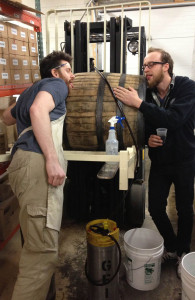
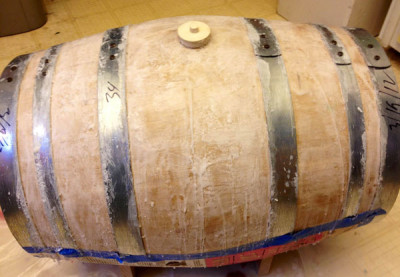
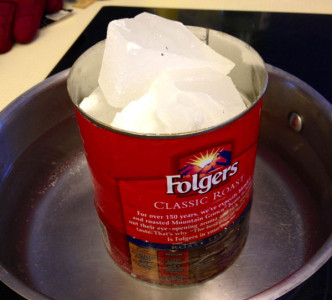
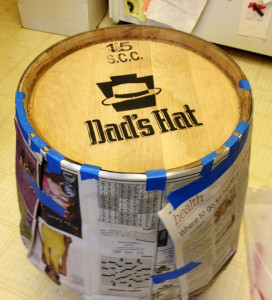
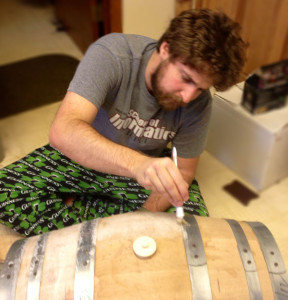
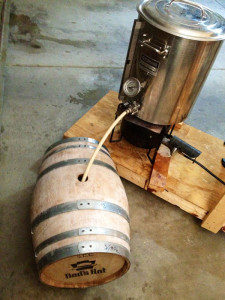
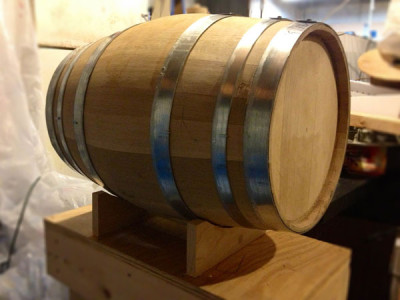
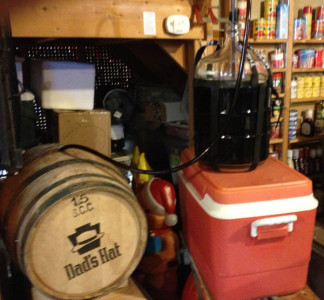
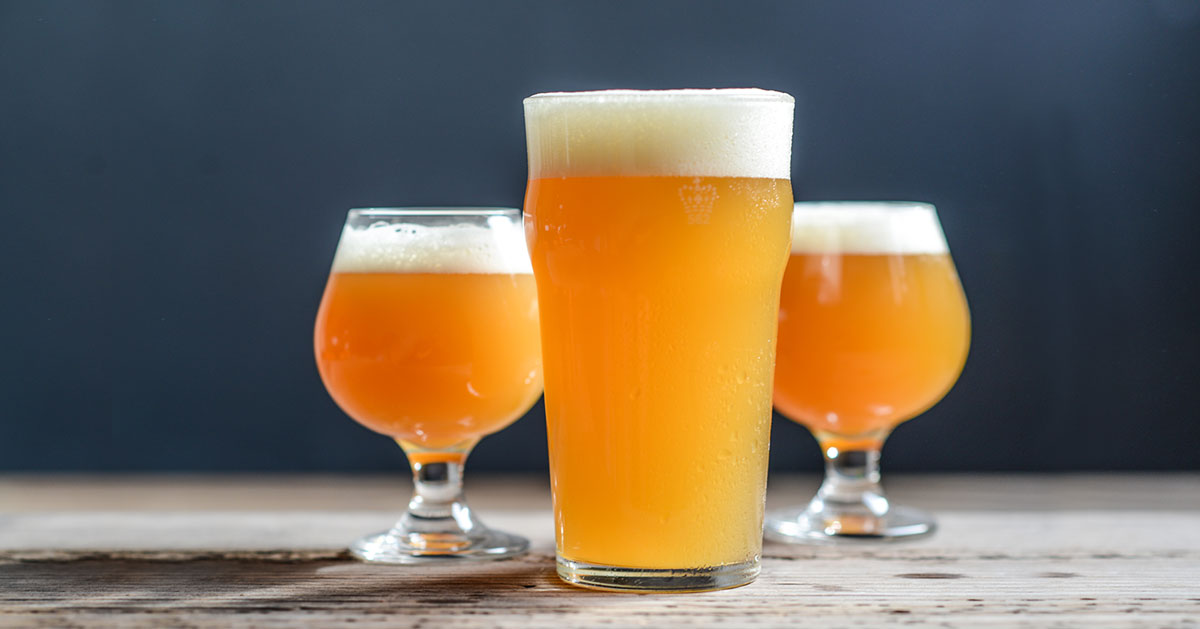
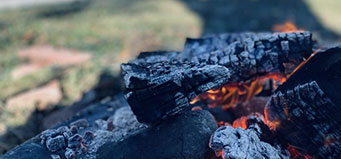

Great post (and nice jammies)! I notice in your last picture, you are siphoning what looks to be approximately five gallons of beer into your 15 gallon barrel. Is it better to fill it all the way up?
Also, do you anticipate Great Fermentations having barrels on hand often? I’m moving soon and wont have my brewery back together for a few months. I’m guessing I would want to use the barrel ASAP to avoid getting those sour tastes you mentioned.
Thanks,
Brad
Brad – It is definitely easier if you can fill it all the way to help with preventing oxidation. If you can’t that is where the wax can come in handy to help block oxygen from getting into the deadspace. In terms of us having these barrels often, the answer is no. We get them in from time to time, but it is not a regular occurrence that we can plan for. We just get them when they’re available. Yes you would want to use them ASAP.
Cheers!
Bryan
Yes, this is super helpful. I was lucky enough to receive a 10 gallon used whiskey barrel as a gift, and I’ve now started working on it. I’ve already filled it up with 180 degree water and let it sit so the wood could swell, and I also plan on waxing it per your method.
My question is about the whiskey characteristics: I’m assuming the water extracted much of the flavors already, so I should probably recondition the barrel with more whiskey. Does this sound right? And any advice on how much to use, or how long to let the whiskey stay in there? Thanks!
Mike – Wes here with Great Fermentations. Good Question! If you did sanitize the barrel with 180F water, then a little extra spirits in the barrel certainly won’t hurt, especially if you are looking to give your beer an extra spirit “kick.” From what research I’ve done, just enough spirit to slosh around and cover the inside of the barrel should be enough. From what I have read, just enough time to cover the barrel should be enough to refresh that flavor, but you may try leaving it in for 15 minutes to an hour if you are looking for a time frame. Empty the barrel of the whiskey, and perhaps leave it sit for a little while upside down so that excess spirits can drain out. After this, rack your beer in immediately.
While the pasteurization of the barrel will help it to get clean and swell, it shouldn’t remove all of the spirit flavor, as this should have penetrated well into the depths of the staves. Not only that, but a lot of the oak flavors compounds that contribute flavors and tannins should be pretty well intact if the barrel has only been used previously as a one use whiskey barrel.
I hope this helps! Good luck to you in your barrel project, I have a feeling it is gonna be awesome! Cheers, Wes
So I did not use my barrel and let it sit for longer than I should have (year(s)?). It leaks of course, so I’m sure the wax would help. Also, can I sanitize it with 180 degree water and some potassium metabisulfite? I know that I’ll need some liquid in there so the wood can expand.
Evan – Wes here with Great Fermentations. I would recommend a holding solution to swell your barrel and for storage until you are ready to use it. This holding solution is recommended by Daniel Pambianchi in an article called “Keep it Clean” From Brew Your Own. Basically, it is 1 tsp citric acid and 1.5 tsp potassium metabisulfite for each gallon of barrel volume. Dissolve these in 1 gallon of hot water, fill the barrel 2/3rds full of water, add the holding solution, and top off with cool water, and placing a bung in the barrel. Daniel recommends topping off with holding solution once a month and rotating the barrel 45 degrees in either direction to keep the bung area from drying out. This solution can help keep your barrel sanitary and swell it so it does not leak. Do be careful, as the holding solution can eat concrete, so rinse away any solution that leaks out with water. I hope this helps! Of course, props go to Daniel Pambianchi and his awesome article, which is worth a read! Cheers, Wes